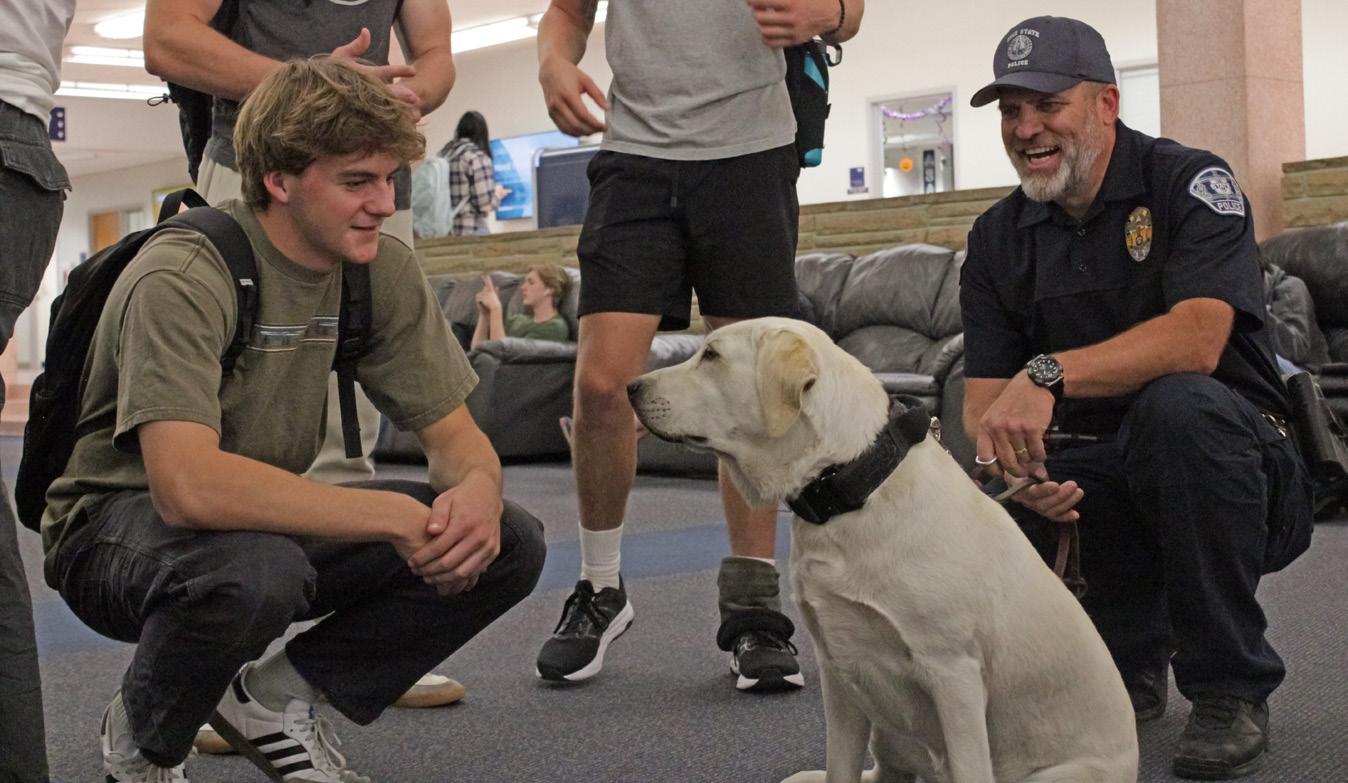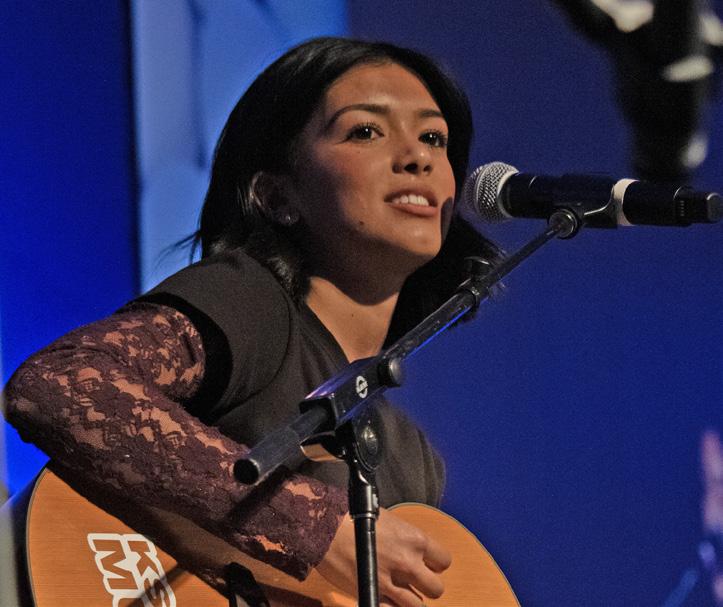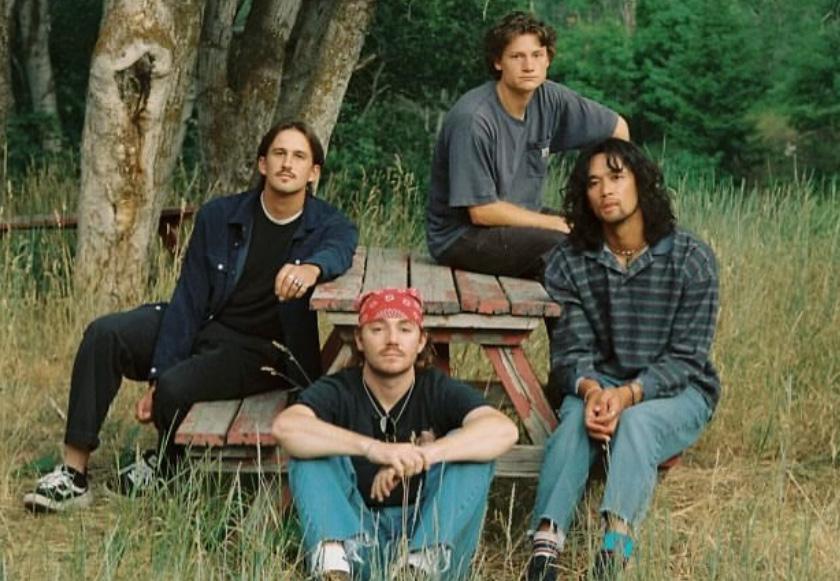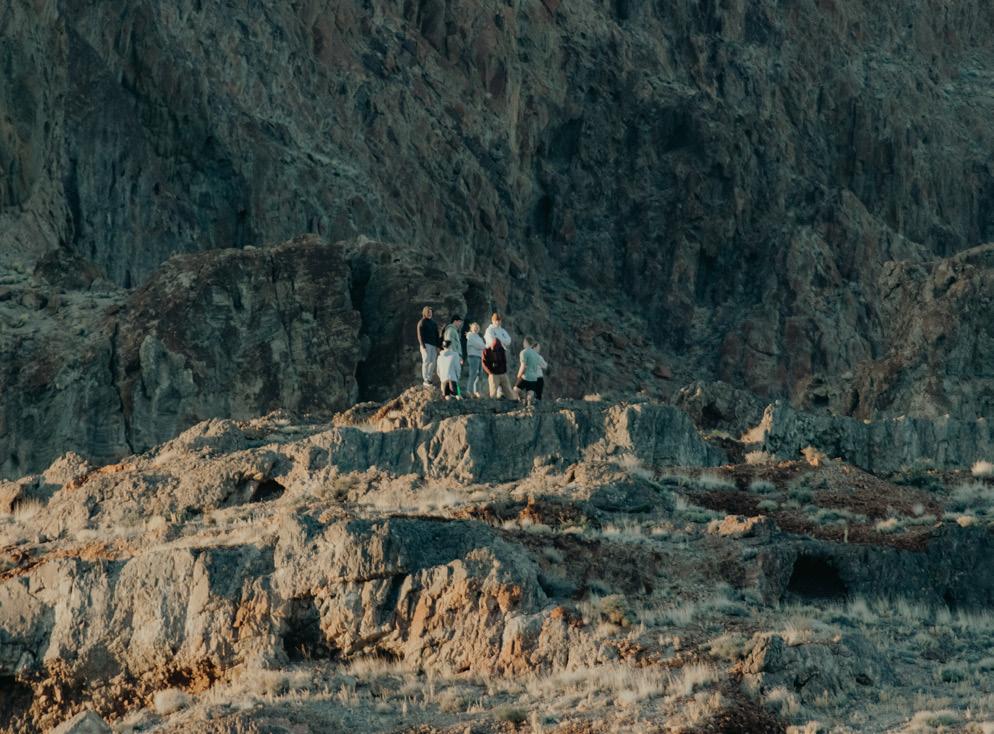




By Bailey Daniels STATESMAN REPORTER
Anew official Utah State University social media account has been showing up on feeds, featuring K-9 officer Sage on Instagram at @ sage.usu.policedog
She has been posted doing activities like watching a university basketball game and doing therapy work at Cache Alternative High School. The labrador retriever has been working at USU since 2023, tasked with crisis response, critical incident and community engagement. Now, she is also gaining popularity on social media.
Sage’s handler and account manager Officer Shane Nebeker spoke about the decision to introduce her to social media.
“The big reason we wanted to do that is — and not that I’m opposed to it one bit, but — she is becoming a meme,” Nebeker said.
On Feb. 6, parody Instagram account @thefakesman made a post jokingly inaugurating Sage as the new president of USU.
“President Sage’s office has been fully equipped with a play pen, toys, and unlimited treats, according to inside sources,” the post wrote.
Although amused, Nebeker wanted to make sure Sage’s mission isn’t overshadowed by playful posts made about her.
“Yes, she’s a lot of fun to be around. She does a lot of fun things, but she has a really serious role, which is part of the reason I’ve been posting some of the things that we’ve been doing over the last couple of weeks,” Nebeker said.
The USU Department of Public Safety is also active on Instagram and has a lot of posts of Sage as well. Another inspiration for starting Sage’s own account was Nebeker worrying about dominating their Facebook and Instagram accounts with content of Sage and overshadowing their goals.
Nebeker first posted on Sage’s account on March 12, and the account now has over 800 followers.
“I did one collaboration with the HURD, and we got her about 600 followers in 20 minutes,” Nebeker said. “I was looking at the dashboard today. Her profile has been viewed 11,000 times in the last week and a half.”
The account has received a lot of support from fellow official USU accounts such as the Sexual Assault and Anti-Violence Information Office, or SAAVI, and USU Athletics.
“SAAVI loves all the hard work that Sage does for USU,” @ususaavi commented on one of Sage’s posts on March 27.
Sage is often seen walking around campus with Nebeker, and students are welcome to come and greet them. There are also K-9 trading cards, depicting both of USU’s police dogs. Aside from Sage, Zoomer is a K-9 who is a certified law enforcement explosives detection dog. If Aggies are able to find them and their handlers on campus, they might be able to obtain a trading card with a photo of one of the dogs.
“That has been really positive as well,” Nebeker said. “We can kind of spread the message that way. I’m seeing her card on the backs of phone carriers now.”
Despite the quick popularity of the account, Nebeker hasn’t been very active on social media prior to this new endeavor. His children and colleagues have been able to help him come up with ideas for content.


putting her out there in the correct light,” Nebeker said. “She does have an important role, so I’m trying to be careful to make sure that we’re putting her out there in an appropriate way and showing what she does.”

“I’m an old-timer. My generation is with Facebook, but Instagram is new to me,” Nebeker said. “Some of the younger officers helped me with ideas on things that we can do to make it look more professional and not like some old man is doing it.”
With her comments flooded with support and declarations of love, Nebeker said it’s clear the impact Sage has had on USU and the community.
“The only hesitation would be to make sure that we’re

Bailey Daniels is a junior studying technology systems. She loves Lana Del Rey, sweet treats and all things whimsical.
— bailey.daniels@usu.edu
By Esther Owens STATESMAN REPORTER
Since winning Aggie Voice in December, Swetha Bharat has been juggling the many opportunities that have opened up in her music career while still focusing on school.
Q: How would you describe the style of music you create?
A: When it just comes to music in general, I literally love everything, but I think when I make music, it’s always singer-songwriter-esque — like, girl with a guitar. It’s always a love song. I’ve never been in love, which is really, really funny, but it’s always a love song or something about a boy. Very acoustic and raw is kind of just how I make my music.
Q: When did you get into making your own music and songwriting?
A: I started writing songs when I was like 11 for fun. I would make up little things in my head and jot them down mostly. I am
just the kind of person that loves the ‘what ifs.’ I’m constantly always dreaming about something. I feel like it was a very good way for me to get it all out. Everything I wanted in life, I’d write about pretty much. But also, growing up is hard. A lot of things are hard. So, I think that writing at such a young age was such a good outlet for me to kind of just understand what I was feeling.
Q: What does the creative process look like for you?
A: It’s literally different every time, but usually, it’s because a lot of my songs have been melody first, lyrics after. Some songs have been lyrics first, melody after. If I’m in a rut and I’m like, “I need to freaking write a song,” I will sit down and force myself to come up with something on my guitar, and then I’ll be like, “Okay, what do I want to write about?” But most of the time, my best songs have just been something that’s going on in my life. Let me just pick off of it as inspiration and dramatize it.



Esther Owens is a sophomore studying journalism. When she’s not busy working on a story, you can find her at the climbing wall.
— esther.owens@usu.
By Essence Barnes STATESMAN REPORTER
AUtah born and bred pop rock band is bringing their take on pop rock to the 2025 End of Year Bash. Known professionally as CAYSN, they have been writing, producing and performing original music since 2022.
Q: What’s the story behind your band name?
Caysen, guitar/vocals: Originally, it was just going to be me as a solo, and they
were going to help with things, and then I was like, “I like these guys so much. We want to make it a little more of a group effort.” So, we ended up changing it to CAYSN, like it is now in all caps without the E, just so it gives more of an artist and project feel.
Q: How would you describe your sound to someone who hasn’t heard your music before?
Caysen: I would definitely say pop rock, as simple as that, for sure. I guess my influences, at least with this, are like LANY and Band Camino.

Gabe, drums: I’m a big Twenty One Pilots and Jon Bellion fan. If you listen to our music, it’s cool to find a little bit of the spectrum between that pop and alternative side all the way to the rock of like the Wildlife and Band Camino.
Q: What influences your music the most?
Caysen: Definitely personal experiences. Everything we’ve made and released has been a true story, like what we’ve gone through. The majority of the songs I’ll bring to them, and those are my experience of stories. But one of the recent songs was actually Gabe’s from a while ago, and then we revisited his experience.


newspaper for Utah State
since 1902. Reporting online 24/7. Printed weekly during the school year.

April 7, 2025
By Layla Alnader STATESMAN REPORTER
The Last Wild Buffalo vaguely defines themselves as Americana, influenced by bands like the Avett Brothers. Utah natives Troy Lybbert, Ella Celaya, Jonny Celaya and Isaac Woodruff officially began composing and performing together in June 2024, closing the year off with 116 shows played.
Q: What prompted you all to pursue music?
Troy, upright bass: I just grew up in a house full of music. My dad grew up in San Francisco in the ‘80s, which was this glory era for classic rock and blues and jazz. He has been to so many concerts his eardrums are blown out. I grew up listening to classic rock, blues, jazz and heavy metal — I just grew up listening to all this super raw,
authentic music. That’s where the love for it came for me. We talk about the risk we took and the courage it took, and we just drew off of each other. We all kind of sat down and decided this is what we wanted to do. None of us could have done it without the other person.
Ella, vocals/fiddle: When I was really young, I latched on to these old and traditional genres. They just made me want to sing all the time. I was put into fiddle lessons when I was four. I played the piano as well. Isaac, our guitarist, taught me how to play the guitar when I was 14 or 15. I think it helped that we grew up together. It was motivating for me to see Jonny and Isaac grow into their musical craft — it made me want to get better. There’s a certain motivation behind us always being together and being so close. I feel like I know a lot of bands where band members are kind of hired on, and it makes a big difference.

By Aubrey Holdaway STATESMAN REPORTER
Since 2018, Utah’s Lovingly Clad has evolved from a group of high school friends jamming together to a full-blown band. Blending styles like rock, blues and shoegaze, they’ve played all across Utah, as far south as St. George and north as Logan.
Q: How did you guys get started playing together?
Cedric, vocals/rhythm guitar: Me and Nolan were in high school, and we kind of just jammed together a lot. I played bass, and he played guitar, and we jumped from group to group. Eventually, we found Luke, who was learning how to play the drums, and we just decided to start playing with each other. A few jam sessions started to turn into consistent meeting times, and it was actually Luke’s idea to make it official.
Nolan, lead guitar: Zach has been a really close friend of ours since we were young as well. He didn’t really have any background in playing an instrument or anything, but one night, we were hanging out in an apartment that me and Luke lived at, and we had this mini basketball hoop opposite corner of the room, and I told Zach, “Hey, if I make this shot, you’ll become our bassist.”
Cedric: I will say, from the opposite corner of the room, there’s no making this shot.
Nolan: He agreed to it, not wanting anything to do with playing in a band, and I made the shot. He said, “Shoot it again,” so I took the same shot, and I made it again. Then he looked at me, and he said, “Alright, I’ll see you at practice on Wednesday.”
Q: How would you describe your sound to somebody who hasn’t heard you guys play?
Cedric: I’m so glad you asked. We don’t know. We usually like to use the words shoegaze-y, bubble gum, blues rock, with a lot of instrumentation and dynamics.
Q: What is the biggest influence for your songwriting?
Zach, bass: I feel like a lot of it is driven by ideas — it’s kind of corny, but it opens a lot of doors. One of us will be like, “Guys, we should put in the key change. We haven’t done a key change in, like, forever,” or “We could do — we should slow it down right here because I heard this song, and they did this a lot of times.” It’s also what’s in our life at that moment, and like Nolan said, it just blooms off of that.
Cedric: That’s what makes a Lovingly Clad song a Lovingly Clad song. It’s hard to pinpoint how our writing process really goes down, but if one of us were gone — if any one of us or the components of songwriting were missing — then it wouldn’t be Lovingly Clad. The project is us and what we collectively can make with our own tastes.
Kaden, manager: I’m going to try my best to give you an answer from the perspective of Jonny and Isaac, who really founded the band. They grew up together — they were childhood neighbors who always played music. When they were kids, they made a promise that they would go to college together and start a punk rock band. They started the band with no drummer in elementary or middle school, parted ways, then wound up at Utah State. To call it a labor of love is kind of misrepresenting it — they would not be doing anything else. If they have free time, it’s spent thinking about or making music.


Layla Alnader is studying public health. She loves music, hiking, writing and the sun.
— layla.abdulmohsin@usu.edu




By Brook Wood STATESMAN REPORTER
Sunhills is a five-piece dream pop band made up of Drew Nicholson, vocals and rhythm guitar; Cameron Zitting, lead guitar and sound engineer; Sam Olson, drums; Leo Canaan, bass; and Nico Canaan, keys.
Q: How did you all come together as a band?
Drew: Aside from Nico, we all met at a speed dating event at Sugar House Coffee way, way back — preCOVID. We didn’t do super great or just didn’t really match up, and we were all just kind of standing in the parking lot and all became friends and realized that we all played music and started hanging out more — one of those movie things where you become friends with people the first time you meet. And then we got together and started making music and recording and playing shows. Leo and Nico are cousins, and Nico is also a musician and has their project, so they have been around the scene a lot. We were all big fans of their music, and they loved coming to see us play, so they joined us playing keys, and that’s been us ever since.
Q: What’s the story behind your band name?
Drew: I was trying to come up with band names for a long time and trying to figure out what felt right. I feel like music and a lot of art — but for some reason, music especially — takes you somewhere. It’s such a visual medium, even though it’s just sound. It clings on to memories that you have, and it clings on to people that you know. Songs will recall a certain smell or certain season, and the songs that we were making at the time felt really euphoric and warm. I just have this image of being in the car and it’s summertime, and you’re finally getting up this mountain and going down, and I feel like Sunhills feels like a place that you
go in your mind. It just felt like a good fit, and it felt like it represented where the music could take you.
Q: What is the process for writing your music?
Drew: The way the process works usually for us is a song will start out just from me, so I’ll write the basis of the song, which is usually like the chord progression, the melody and the lyrics, and then I’ll either make kind of like a quick demo of it to send to everybody, and then we’ll work on it together, or we’ll just kind of go through it as we go in band practice. There’s a couple times that songs have come out just through jams, but I usually bring the foundation — kind of like the nugget — and then we extract it and build on it and change it a bunch.



Brook Wood is working towards receiving a bachelor’s degree in literature. When they aren’t writing or reading, they enjoy playing the violin in the USU Symphony Orchestra and the occasional sweet treat.
— b.wood@usu.edu






Getting excited for End of Year Bash? Get even more excited by checking out some of the top songs by this year’s performing artists. Lifetimes

BUTTERFLIES CAYSN

Breakfast in Bed
The Last Wild Buffalo Soup Lovingly Clad


You Love Me ‘Cause You’re Bored Sunhills


By Rain Schenck STATESMAN REPORTER
Closing out her final season at Utah State University, senior Indya Nespor leads the women’s tennis team with a record of 8-5, leaving behind what head coach Veronika Golanova classified as a season full of hard work and relentless competition.
Recruited from California State University, Fullerton, Nespor has played for the Aggies since her sophomore year of college. Her decision to enter the transfer portal was motivated by her hopes to play more tennis and move to an environment with high school spirit, she said.
Competing at the NCAA Division I college tennis level had always been a dream for Nespor — a dream she said didn’t come with just raw talent.
“My dedication I’ve given to tennis — my openness and happiness and hardworking,” Nespor said. “I grew up with tennis.”
Born in San Diego but raised in the Netherlands, Nespor began competing in tournaments when she was 11 in Holland. Tennis quickly became her “everything” after moving back to the United States, where she spent most of her time after school practicing in what she calls the “competitive” atmosphere of California tennis.
Being recruited by Utah State was the first step in her plan to play what she called “her style of game” and to

kickstart the journey of becoming the best tennis player she could be.
Becoming this type of player started early on in her sophomore season at Utah State. Golanova, then assistant coach of the team, began working with Nespor to find her rhythm of play. Golanova said Nespor was discovering her type of game her first year, and as she has put in the time these last few years, she has grown into a player who knows her style and is confident in her game.
“Her mental toughness,” Golanova said, remarking on the biggest area of growth for Nespor. “Her competitiveness.”
Nespor attributed her growth as a college tennis player to her supportive family and Golanova, who stuck with her.
“She has shaped a lot of my game and helped me build the confidence I have now,” Nespor said. “She, more than any coach ever, knows me and knows my emotions.”


Rain Schenck is from Syracuse. She’s a senior at USU studying journalism and communications. If she’s not writing or reading, she can be found at any competitive event or game night, throwing a ball or yelling at a card game.
— A02339636@usu.edu


By Carson Frost STATESMAN REPORTER
Editor’s Note: All stats and records are as of April 3.
Utah State University Softball, now just over two weeks back in Logan after spending a month and a half on the road, is establishing itself as a fierce foe in the Mountain West Conference.
At the time of writing, the team has improved its conference record to 6-2, tying for first place in the conference. The Aggies’ most recent home victories came in a doubleheader on April 2 against New Mexico, winning 7-6 in 12 innings in the first game and securing an 8-6 victory in a five-inning second game.
Due to cold weather, the team spent the entire first month of the season on the road. Their home opener came on March 12 with a 9-8 win against Utah Valley.
The extensive travel and packed schedule can cause some fatigue, but the Aggies appear to be finding a second wind in their recent performances.
“Other than those first two weeks of the season, we’re probably playing our best ball,” head coach Todd Judge said. “I think for the first time, like maybe all year, all three phases are working together.”
The three phases Judge is referring to are pitching, batting and fielding.
Here’s a look at how each of those phases has been shaping up so far this season:
While USU Women’s Soccer climbed to No. 7 in the nation last fall, the softball team’s batting lineup might be the strongest collection of players on campus this school year. Going down the lineup reveals a list of accolades for virtually every player.
First baseman Giselle Gonzalez joined rare Aggie company when she was named National Player of the Week during the week of Feb. 24. Her .409 batting average, .748 slugging percentage, 47 hits, 46 RBIs and 12 home runs all rank among the top five in the Mountain West.
Shortstop Ariel Fifita was recently ranked as the No. 6 best
player at her position in America in the D1Softball midseason positional rankings. She ranks No. 3 in the conference with a .416 batting average, No. 3 with 42 runs scored, No. 1 with 14 doubles, No. 2 with 52 hits, No. 3 with a .526 on-base percentage and No. 4 with 22 walks.
Catcher Kaylee Erickson made history on March 23 with her fourth grand slam of the season, tied for second-most in a single season in NCAA history.
Catcher and infielder Grace Matej earned Mountain West Player of the Week honors during the first week of the season. She has ranked among the top 20 players in nearly every batting statistic in the conference.
In the eight games since conference play began, right fielder Kya Pratt has dominated the leaderboards, ranking No. 4 with a .500 batting average, No. 4 with an .864 slugging percentage and No. 3 with a .593 on-base percentage. Pratt was particularly dominant in the doubleheader against New Mexico, going 5-for-7 with two home runs and seven RBIs.
“She had a very, very big game there, for sure,” Judge said. “She’s just had a great year. She goes full speed, never complains, just kind of does her thing.”
When it comes to fielding, Utah State is among the best in the Mountain West.
They are tied for No. 3 in the conference with a .969 fielding percentage, No. 2 in the nation with 362 assists and tied for No. 1 in the Mountain West with 16 double plays.
Their Achilles’ heel at times has been errors. With 34 on the season, they rank No.4-worst in the conference, but this could be attributed to their willingness to take risks.
Of the 15 players in the Mountain West with a perfect 1.000 fielding percentage, four are Aggies: Matej, Pratt, Faith Kroening and Brooklyn Pritchett. No other team has more than two perfect fielders.
The defensive combo of shortstop Fifita and first baseman Gonzalez has been deadly. Gonzalez leads the conference with 320 putouts, and Fifita’s 117 assists are the most by any player in the country.
Pratt, who was an all-around star in the recent New Mexico doubleheader, showcased her skills as an outfielder at a
crucial moment in the 10th inning. With one out and the bases loaded, she dove for a flyball in deep right field and in one seamless motion, threw it to first base for a double play.
Judge believes her play saved the game, and while Pratt was confident in her ability to make the play, she made sure to credit her teammates.
“I knew I could make that play,” Pratt said. “I knew that Gigi [Gonzalez] was going to be at first base, and just seeing her getting up fast and popping it back to her — I think it was just the chemistry between all the team and the drills we do in practice that prepared me for that.”
The pitching has had its rough spots for Utah State this year.
They are ranked No. 2-worst in the conference with a 6.28 ERA, worst in opponent batting average at .350, worst in strikeouts with 105 and tied for worst in home runs allowed with 34.


Carson Frost is a transfer student from Denver studying journalism. His family originally hails from Los Angeles, and he is a passionate fan of the Lakers, Dodgers and Philadelphia Eagles. He loves writing, making music, hitting the gym and taking road trips.
— carson.frost@usu.edu
By Laura Adams, Gage Farley, Haleigh Howell and Katelynn Illum
Editor’s Note: This column has not been altered or edited by The Utah Statesman staff.
The Flores Family Garden was established by Taya and Tony Flores in 2021 to provide vulnerable members of their community with access to healthy food, a social network and education on becoming more self-sufficient. They offer garden beds to immigrants, refugees and veterans; the garden serves 34 families from 10 different countries.
The garden will have even more garden beds this spring with the goal of being able to serve 70 families and have 10 raised beds dedicated to the Cache Food Pantry.
In addition to the new beds, they are updating their compost area and encouraging gardeners to bring compost from home.
Composting is the use of green organic material waste such as; potato peels, coffee grounds, and eggshells, with a combination of brown organic material waste like; leaves, old newspaper, cardboard, and hay.
When you combine an even amount of green and brown composting materials you can create nutrient-rich soil that is beneficial to growing a garden.
There are many reasons why the garden would want to expand their composting efforts, reducing trips to the landfill has both environmental and economic benefits The reduced use of chemical fertilizers including artificial nitrogen helps both environmentally and economically, especially as these fertilizers often runoff into waterways and cause environmental issues such as algae blooms. By composting instead of sending their green waste to the landfill, the garden also reduces methane emissions that would normally be released into the atmosphere as the waste decomposes.

The economic benefits of not buying chemical fertilizers can make a large impact over time, and the food waste that would otherwise be thrown away will be cycled back into the garden saving more money.
It also increases water retention in the soil, leaving water trapped in the soil for longer periods of time; which means you will be watering your garden less.
By implementing composting into your garden lifestyle you will: save money by not buying fertil -
izers, increase the nutrients in your harvest, save water with the high levels of soil retention, and reduce your waste impact by using organic components into your compost.
For more information on volunteering or community events at the Flores Family Garden, visit their website through the QR code.


By Isabella Erwin STATESMAN REPORTER
Broadway returned to Cache Valley with electrifying performances of “Chicago,” the longest airing musical in Broadway history.
This latest national tour is the culmination of almost 100 years of theater history. In 1926, the original play premiered, written by a Chicago Tribune reporter and based on two real murder trials of the decade. In 1975, the musical adaptation first hit Broadway, playing for a little over two years. Nineteen years later, in 1996, it was revived on Broadway and has been running ever since.
The show takes place in 1920s Chicago and centers on Roxie Hart, played by Ellie Roddy, who after murdering her boyfriend, tries to avoid death row with the help of sleazy lawyer Billy Flynn, played by Connor Sullivan. “Chicago” takes a satirical look at the American criminal justice system and media as Roxie competes with fellow murderer Velma Kelly, played by Taylor Lane, to stay front-page news.
Roddy’s delightful physical acting and comedic timing was on full display in numbers like “We Both Reached For the Gun,” in which she played a marionette doll manipulated by her lawyer. Her extended monologues in “Roxie” repeatedly toyed with audience expectations and had the audience roaring with laughter.
Lane, too, was excellent in her role as Velma. Her smooth, sultry voice was captivating, and as she danced, you understood why ‘20s Chicagoans couldn’t get enough.
A wonderfully talented live band took center stage in the performance, at times interacting with the cast, at times pointedly not interacting. Amos, Roxie’s husband, requested exit music after singing “Mr. Cellophane,” a

number about how “you can look right through” him, as though he wasn’t there. The band did not react to his request, and Amos awkwardly shuffled off stage.
The fourth wall was done away with during musical numbers, where characters were introduced to the audience as if their onlookers were patrons of a speakeasy rather than a theater.
The set, lighting and costumes were understated, yet during big songs such as “All that Jazz” and “Razzle Dazzle,” I was struck by the spectacle. The ensemble was outstanding, and the original choreography by Bob Fosse remains immensely popular for a reason.
The show ended with a final fourth-wall break, as Rox-

ie and Velma took their bows holding impossibly large bouquets and enthused about the importance of “good, old-fashioned American values.”
Without the audience, they said, they’d be nothing. Only in America was all of this possible.
The themes of Chicago are every bit as relevant now as they were in 1926 when the original play premiered. I can’t help but think about Luigi Mangione, the man accused of murdering the UnitedHealthcare CEO Brian Thompson. The sensationalized, non-stop coverage of every newly-revealed detail of Mangione’s life reminds of the central thesis of the musical as stated by Matron “Mama” Morton: “In this town, murder is a form of entertainment.”
The timeless satire, outstanding choreography and addicting score of “Chicago” mean Roxie and Velma will stay America’s murderous sweethearts for many years yet.

Isabella is a sophomore studying journalism and political science. Be on the lookout for them riding a bike around campus for your own safety.
— isabella.erwin@usu.edu








Dane is in his third year at USU studying mechanical engineering. He loves taking photos and anything in the great outdoors.



Last week’s solution:

Sudoku puzzles are provided by www.sudokuoftheday.com.

Nominate influential students, faculty and sta , alumni, and community members for the Utah Statesman’s 50 Influential Aggies!
Nominations will be accepted until April 14th.

